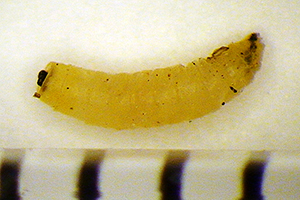 Corriher-Olson did her graduate work in Georgia, where the pest has had a presence since 2010, and she is familiar with the damage it does. The Van Zandt field is the first confirmed instance of the pest in Texas.
Corriher-Olson did her graduate work in Georgia, where the pest has had a presence since 2010, and she is familiar with the damage it does. The Van Zandt field is the first confirmed instance of the pest in Texas.She said the pest is native to southern Asia, common from Japan to Pakistan. Somehow it made its way to the U.S., where it was found in three Georgia counties.
“It’s relatively new to the U.S., and very little is known about its lifecycle yet,” Corriher-Olson said.
 “It is not yet known how damaging this insect will be in Texas,” said Dr. Allen Knutson, the AgriLife Extension entomologist at Dallas who confirmed the identity of larva found in a Van
“It is not yet known how damaging this insect will be in Texas,” said Dr. Allen Knutson, the AgriLife Extension entomologist at Dallas who confirmed the identity of larva found in a Van
Zandt County field of irrigated Bermuda grass this summer. What is known is infestation begins when the adult fly lays its eggs on a Bermuda grass stem near a node, Knutson said. The larvae, which grow to be about an eighth-inch long, look like a pale yellow maggot.
They burrow into the Bermuda grass shoot to feed. This feeding causes the top two to three leaves to wither and die. Cutting open the stem just below these dead leaves will reveal the maggot and the brownish feeding site on the stem.
The adult flies may go unnoticed; they are small with dark eyes, Knutson said. The early stages of an infestation may go unnoticed too, Corriher-Olson added.
“People are not going to realize they have the pest until they see the damage,” she said. “It looks similar to what you might see from a light frost. Stem tops are whitish or lighter in color than unaffected plants. Only the top parts of the shoots are damaged. The lower leaves on the shoot remain green. The leaves above the feeding site wither and die.”
To further complicate identification, the larva may have already developed into flies and left the plant before their damage is apparent, Corriher-Olson said. And there may be several generations each summer. The fly’s life cycle is usually about three weeks, but it can be as short as 12 days.
Dr. Larry Redmon, AgriLife Extension state forage specialist, College Station, noted unconfirmed reports of the Bermuda grass stem maggot have been coming to his office since last year.
“We had a call from a producer in Waller County during 2012, which was the first one I know of,” he said. “Additionally, we have had a report of what appears to be stem maggot damage in Comanche County this year.”
The amount of yield reduction seems to depend upon growing conditions, Corriher-Olson noted.
“Typically, damage is more likely to be found in a hay meadow, not in a grazed field, because the flies won’t have time to complete their life cycle,” she said.
Management strategies depend upon how near the hay crop is to harvest when the damage is identified, Corriher-Olson said.
“If damage is found within one week of harvest, the recommendation from Georgia is to harvest as soon as possible,” she said. “The longer they wait, the more likely the damage will spread, and there will be further reduction in yields.”
If the pest and its damage are confirmed one to three weeks after the previous harvest, the recommendation is to cut the damaged areas, bale the damaged grass, and remove it from the fields, Corriher-Olson said.
“The only threat posed by leaving the hay in the field is that it’ll compete with any attempts of the plant to regrow, therefore decreasing the yield of the next cutting. Leaving the hay in the field does not increase infestation,” she said. “It’s unlikely that the damaged areas will contribute significantly to yields during the next harvest.”
The pest can also be controlled with foliar applications of several inexpensive insecticides, Knutson said. Current recommendations are to treat after a cutting if damage levels are high. However, economic thresholds for treatment in Texas have not yet been established, he said.
All three ag specialists recommend producers who suspect they have an infestation contact the extension agent in their county to confirm they have the pest before treating or using other control measures. You may also contact Corriher-Olson by email or at (903) 834-6191. FG
—From Texas A&M AgriLife Extension Service news release
PHOTOS
Photos courtesy of Texas A&M AgriLife Extension Service.









